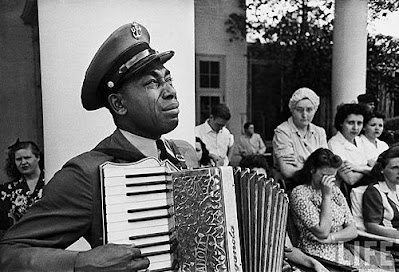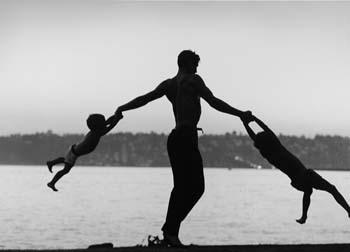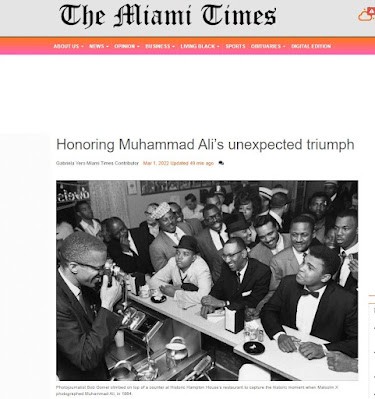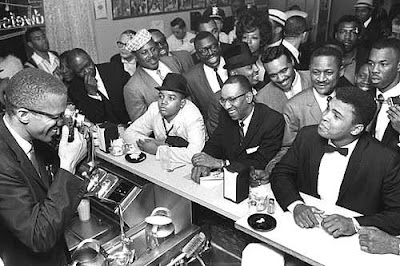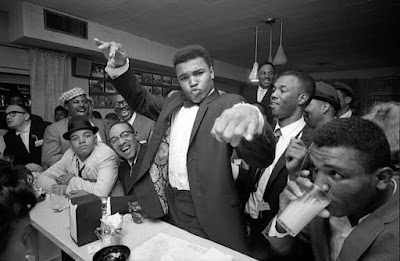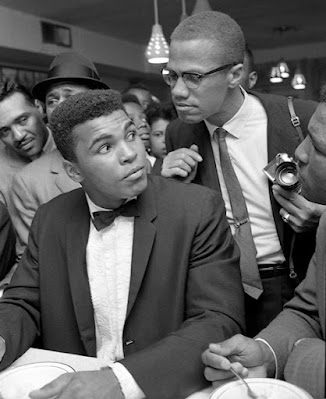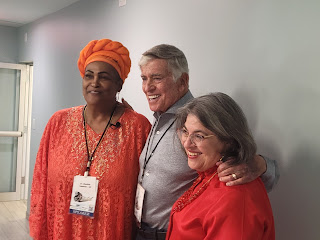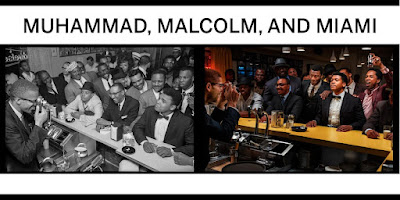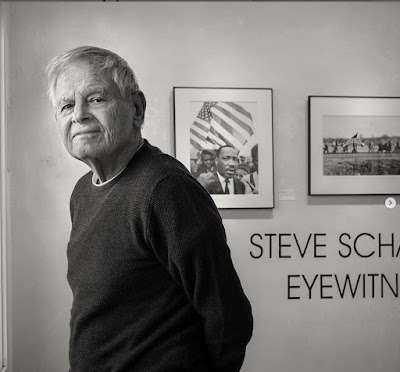Wednesday, August 3, 2022
Richard Skipper Celebrates the world of Bill Eppridge with Adrienne Aurichio
Monday, June 27, 2022
The Truth in Tears….
June 27, 2022
Ed Clark/Life Picture Collection: Navy CPO Graham Jackson as he Plays 'Goin' Home' on the accordion while President Franklin D. Roosevelt's body is carried from The Warm Springs Foundation, where he died suddenly of a stroke on April12, 1945 Courtesy Monroe Gallery of Photography
One of the proudest associations I have enjoyed in my career is my long time affiliation with the Monroe Gallery in Santa Fe. The gallery represents historically important photojournalism, and Sid and Michelle Monroe are fierce advocates of the importance of photojournalism, and equally fierce defenders of the artists who create the work they show on their walls. They are also amongst the most knowledgeable people in this industry, steeped in the history, legends and lore of this art and craft.
On Friday, July 1, they launch an important exhibit. “Imagine a World Without Photojournalism,” which is a date that coincides with the gallery’s 20th anniversary in Santa Fe. Their walls will simply vibrate with famous, important, provocative, challenging, memorable, sad and glorious slices of our life and times. The images enrich, enrage, dismay, and soothe the soul. Your eyes and heart will never be the same after seeing this collection of work.
Sid and Michelle are dear friends, and they know me well by now. Whenever I sell an image through the gallery, I never ask for the money. I leave it with them, building a bank account over time, at the gallery. When I have enough stashed to afford a print, I choose one. Such as CPO Jackson, above, in the banner photo. I have it on my wall, and see it every day.
Made by the formidable LIFE staffer Ed Clark, it depicts Navy CPO Graham Jackson as he plays “Goin’ Home” on the accordion while President Franklin D. Roosevelt’s body is carried from The Warm Springs Foundation, where he died suddenly of a stroke on April 12, 1945. According to accounts, he had a personal relationship with FDR, thus his grief, so poignantly manifest in this frame, is both about the loss of a leader, and a friend.
The picture is just as searing, relevant and heart wrenching today as it was the day Mr. Jackson was playing that accordion, and Ed Clark clicked a shutter button. Without the hearts and minds of photojournalists, a picture like this doesn’t exist. Without the photographers who are risking their lives in Ukraine, we don’t know and thus can’t feel the weight and horror of the madness raging there.
Photojournalists are often not welcome, as we show, in unflinching fashion, things many don’t want to see or recognize. But visual storytelling is more necessary than ever. As our country devolves into vengeful tribalism, and skepticism flourishes, nourished by unalloyed ignorance, I look at CPO Jackson’s face from long ago. There is truth in the tears.
Sunday, June 19, 2022
Monroe Gallery exhibit looks at history through Life’s photographs
By Kathaleen Roberts June 19, 2022
The Beatles, Miami 1964,” at a private residence after their appearance on “The Ed Sullivan Show.” (Courtesy of Bob Gomel)
SANTA FE – When Sidney and Michelle Monroe stepped into the workplace of the great photojournalist Alfred Eisenstaedt decades ago, they were more than intimidated.
“There’s a picture of Hitler and Mussolini shaking hands in his office,” Michelle Monroe said. “We’re not peers.
“Honestly, we could barely catch our breath, we were so star-struck.”
That meeting in New York’s Time-Life building would launch a career of exhibiting some of the most pioneering photojournalists in the country. Monroe Gallery will celebrate the glory days of Life magazine with about 40 images by such photographic luminaries as Eisenstaedt, Margaret Bourke-White, Bob Gomel and Bill Ray through June 26.
Known as the father of photojournalism, Eisenstaedt is best recognized for his image of a sailor kissing a nurse in a dance-like dip during Times Square’s V-J celebration in 1945. When the Monroes approached him, he had never shown his work in a gallery before.
In 1963, Life assigned the photographer a photo essay on life in Paris.
“He didn’t know what he could do that Henri Cartier-Bresson hadn’t done,” Sidney Monroe said.
While he was walking the streets, Eisenstaedt spotted a playground with a puppet show of “St. George and the Dragon.” He crawled under the stage and began shooting the crowd from beneath the drape. The photographer captured the children in the audience, their facial expressions tumbling from delight into fear and horror.
“It’s almost timeless, aside from their clothing, it could be any time,” Sidney said. “It’s a great example of what a photographer does.”
Gomel was already in Miami to shoot the Muhammad Ali-Sonny Liston fight when his editors asked him to photograph the Beatles. The foursome had flown south to relax immediately after their 1964 “Ed Sullivan Show” debut. Gomel shot them sunbathing at a private home.
“The editor of Life was really interested in the world of pop culture,” Sidney said. “The Beatles would sell so many magazines.”
Carl Mydans had been captured by the invading Japanese when the Philippines fell during World War II. He was freed during a prisoner exchange in 1943.
In 1945, Mydans photographed the Japanese formal surrender on the deck of the battleship USS Missouri in front of Gen. Douglas MacArthur.
Mydans had also shot the famous image of MacArthur wading onto a Philippines beach.
“When news came of the formal surrender, it was bedlam,” Sidney Monroe said. Mydans approached a MacArthur aide to make sure he gained entry to the ship.
The photographer captured the iconic moment while he was straddling a cannon. As soon as he shot the photo, a sailor pulled him off.
“The U.S. officials came in wearing their day-to-day khakis, much to the displeasure of the Japanese,” Sidney Monroe said.
Bourke-White was the first photographer hired by Life.
When she photographed Mahatma Gandhi in 1946, he insisted she learn to spin in order to have an audience with him.
“He had no time to digress from his campaign to free India from British oppression,” Sidney said. “She needed him and he knew he needed her.”
Founded by Henry Luce, publisher of Time magazine, Life was long one of the most popular and imitated of American magazines, selling millions of copies a week. Published weekly from 1936 to 1972, it emphasized photography.
“They’re all in their very defining moments,” Sidney Monroe said. “The moments are in our heads because they’re part of our history.”
If you go
WHAT: “The LIFE Photographers”
WHERE: Monroe Gallery of Photography, 112 Don Gaspar, Santa Fe
WHEN: Through June 26
CONTACT: monroegallery.com, 505-992-0800
Thursday, May 5, 2022
LIFE Magazine Show Opens At Monroe Gallery Of Photography
Like thousands of New Yorkers, Sid and Michelle Monroe left the city after the events of September 11 to find a new home. They chose the art and cultural capital of Santa Fe, New Mexico, where they opened the Monroe Gallery of Photography in April 2002. Now, twenty years later, they’re celebrating their gallery’s anniversary by revisiting the topic of their first show: the photographers of LIFE Magazine.
Opening on May 6, 2022, the show celebrates what the Monroes call LIFE’s “stunning affirmation of the humanist notion that the camera’s proper function is to persuade and inform.” Photographs from essays by LIFE icons such as Margaret Bourke-White, Alfred Eisenstaedt, Carl Mydans, and Andreas Feininger will be on display. LIFE photographer Bob Gomel, now 88, will also be in attendance at the opening reception from 5-7pm on Friday, May 6.
LIFE.com recently caught up with the gallerists Sid and Michelle Monroe over email to learn more about their show and their thoughts on LIFE, and, well, life in Santa Fe.
How did you become gallerists? Why did you choose to focus on photojournalism?
We both entered the museum field after college, Michelle with the Cooper Hewitt, Smithsonian Design Museum and Sid with the Metropolitan Museum of Art. Michelle was also a working artist and Sid was the director of a SoHo gallery specializing in fine art editions, where the gallery owner was exploring an exhibition with Alfred Eisenstaedt in collaboration with the LIFE Picture Collection. In 1985, we sat down with Alfred Eisenstaedt to discuss the exhibition and, then in our 20s, were were awed and engaged with his stories of an extraordinary life behind the camera.
We understood that we were in the presence of something bigger than we had ever encountered before. The work of Alfred Eisenstaedt is our collective history—we didn’t live this but this is what formed the world we were born into. In the eighties, photography was only beginning to gain a foothold in the fine art market, and most galleries were concentrating on the early “masters” of fine art photography. Eisenstaedt, and in general the field of photojournalism, had not been exhibited in a gallery setting. We believed immediately that a gallery which combined the realms of art, history, and reportage would be unique, and that set us on our course.

Alfred Eisenstaedt The LIFE Picture Collection/Shutterstock
Why a LIFE exhibition? Why now?
We had our beginning in New York, and over the course of the 1990s had the extraordinary opportunity to meet, get to know, and work with many of the legendary photographers of LIFE magazine, all in their retirement years. Through countless conversations, we learned how they saw the world and recorded it for the magazine, and more importantly, for history. Their work, and work approach, helped us gain insight into how to view their photographs, decades after they made them. Ever since, we have have worked conscientiously over the past 20 years to establish Monroe Gallery of Photography at the intersection between photojournalism and fine art, showcasing works embedded in our collective consciousness that shape our shared history. The Gallery represents several of the most significant photojournalists up to the present day, but the work of the LIFE photographers has been our foundation

What do you wish collectors knew about LIFE? The general public?
The work of the photographers of LIFE magazine came to define the medium of photojournalism, and their photographs recorded history and informed us all for most of the twentieth century. It was long one of the most popular and widely imitated of American magazines, selling millions of copies a week. From its start, LIFE emphasized photography, with gripping, superbly chosen news photographs, amplified by photo features and photo essays on an international range of topics. Its photographers were the elite of their craft and enjoyed worldwide esteem. Published weekly from 1936 to 1972, the work of the photographers of LIFE magazine came to define the medium of photojournalism.

John Dominis/Life Pictures/Shutterstock
Do you have a favorite piece in the show?
Considering we curated the exhibit from potentially thousands of images, the exhibit itself represents our favorites—with enough left over we could easily do a “part two”!
Who are some of your favorite LIFE photographers? Are there some that may have been overlooked?
That’s a difficult question, as each LIFE photographer had their own individual and particular personality and style. We consider ourselves extraordinarily privileged to have been able to have known, and call friends, so many of these great photographers. To name only a few, Eisenstaedt was by many measures the “Dean” of the LIFE photographers and he taught us how to “see”; Carl Mydans left a deep impression on us with his humility and intense humanistic dedication; Bill Eppridge was deeply committed to documenting historic and deeply sensitive subjects; and Bob Gomel‘s versatility and ingenuity impresses us to this day.

© Bob Gomel / Courtesy of Bob Gomel
And for people who plan to visit the LIFE show in Santa Fe, are there other favorite art spots in the area that you recommend?
Santa Fe is a gem of an art-destination city. There are over 200 galleries showing every possible form of art from ancient Native American art and pottery to cutting edge contemporary art. [We recommend] SITE Santa Fe, a contemporary art space; Institute of American Indian Arts; Museum Hill; Georgia O’Keeffe Museum; and Meow Wolf, an ‘immersive art installation where visitors enter and discover that nothing is as it seems…
Do you have advice for young photojournalists who might want to display their works in a gallery?
Foremost, understand and dedicate yourself to the profession and its specific ethical requirements. Respect its role as the fourth estate and its check on power. Do the work. The role of photojournalists has perhaps never been as vital and important as it is today.

The LIFE Photographers exhibit will be on display at Monroe Gallery from May 6 through June 26, 2022. For hours and location, please consult the gallery’s website.
Jill Golden is the director of the LIFE Picture Collection, an archive of more than 10 million photographs created by—and collected by—LIFE Magazine.
Friday, April 29, 2022
Photograph by John Dominis Inside legendary photo agent Lee Gross’ Manhattan apartment
April 29, 2022
Inside legendary photo agent Lee Gross’ Manhattan apartment
Lee Gross, a photo agent who pioneered the capturing of behind-the-scenes movie-set images in the 1960s, talks us through the treasures of her West Village apartment
Wednesday, March 2, 2022
"This past Saturday, Hampton House hosted “Round Five: The Knockout,” a conversation with photojournalist Bob Gomel"
Monday, February 28, 2022
Gallery Photographer Bob Gomel Returns To The Historic Hampton House After 58 Years
This past weekend, Bob Gomel returned to the site of where some of his most historic and iconic images were made 58 years ago.
In February of 1964, Muhammad Ali, then as Cassius Clay, was training for his Heavyweight Championship fight in Miami with Sonny Liston, Bob Gomel was assigned by Life magazine to cover the matchup. Clay was an 8–1 underdog, but Gomel was assigned to take photographs of him in advance of the fight that could be used on the cover of the next weekly Life issue in case Clay upset Sonny Liston.
History was made on Tuesday night, February 25, 1964 as Clay defeated Lison in a 7-round TKO. Bob Gomel was ringside photographing the fight, and instinctively followed the triumphant Clay back into his dressing rom. From there, he accompanied the crowd to the Hampton House Motel for a celebration with ice cream along with Malcolm X and an entourage. The story was later shared on the big screen in the movie "One Night In Miami".
Shortly thereafter, bolstered by his mentor Malcolm X, Clay stepped in front of a room of journalists to declare his conversion to the Nation of Islam. After fielding hostile questions, he voiced the words that would become his lifelong anthem and would forever change the world of sports: “I don’t have to be what you want me to be.”
Monday, February 7, 2022
Muhammad, Malcolm, and Miami: A Conversation with Bob Gomel and Peniel Joseph
Via The Briscoe Center for American History
Muhammad, Malcolm, and Miami:
A Conversation with Bob Gomel and Peniel Joseph
Feb. 15, 2022 • 5:00 p.m. CST • Recording available here
About the program:
Please join the Briscoe Center and LBJ Presidential Library on Feb. 15, 2022, for Muhammad, Malcolm, and Miami: A Conversation with Bob Gomel and Peniel Joseph. The online event is presented in conjunction with the Briscoe Center’s exhibit “One Night in Miami”: From Photo to Film, currently on display at the LBJ Presidential Library.
After his victory over Sonny Liston for the heavyweight championship on Feb. 25, 1964, Muhammad Ali celebrated at the Hampton House, a motel and diner in Miami that served as a gathering place for Black entertainers and celebrities. The evening inspired Kemp Powers’s 2013 play, “One Night in Miami,” which was adapted into Regina King’s Academy Award-nominated 2020 movie.
Key scenes in the movie were inspired by iconic photos taken by Bob Gomel and Flip Schulke, famed photojournalists whose archives are housed at the Briscoe Center. These photos—Gomel’s photographs of Malcolm X and Ali in the Hampton House diner, and Schulke’s underwater photos of Ali—will be the focus of the event.
Bob Gomel will talk about his relationship with Ali over multiple photo sessions, including the “Life” magazine assignment that resulted in the iconic images of Ali and Malcolm X at the Hampton House. Distinguished historian Peniel Joseph will discuss the event’s historical context and share his thoughts on the relationship between Malcolm and Ali. The discussion will be joined by Mark Updegrove, president and CEO of the LBJ Foundation, and Don Carleton, executive director of the Briscoe Center.
The online event is free. Visit https://muhammadmalcolmandmiami.eventbrite.com to register, and you will receive an email the day before the event with the link.
The exhibit, “One Night in Miami”: From Photo to Film, showcases photos from the Briscoe Center’s collections that inspired key moments in the 2020 film. The photos by Gomel and Schulke, many of which have never before been exhibited, depict a young Muhammed Ali (then known by his birth name, Cassius Clay) during the early years of his boxing career. Located in the LBJ Library’s Great Hall, the exhibit is open through May 8, 2022.
About Bob Gomel:
A native New Yorker, Bob Gomel produced numerous noteworthy images for “Life,” including assignments documenting Marilyn Monroe, the Beatles, and this series showing Muhammed Ali with Malcolm X. He later freelanced for “Sports Illustrated,” “Newsweek” and “Fortune” magazines, among others, before transitioning to advertising photography. Gomel has received numerous awards during his career and continues to travel and photograph international subjects. His archive at the Briscoe Center ranges in date from 1959 to 2014, and includes film negatives, contact sheets, and exhibit prints. He currently resides in Houston, Texas, with his wife Sandra.
Tuesday, January 25, 2022
Remembering Steve Schapiro
Steve Schapiro died peacefully on January 15 surrounded by his wife, Maura Smith, and son, Theophilus Donoghue in Chicago, Illinois after battling pancreatic cancer. He was 87.
The New York Times: Steve Schapiro, Photojournalist Who Bore Witness, Dies at 87
“You didn’t get the sense from his photographs that Steve was even in the room,” Sidney Monroe, co-owner of a photojournalism gallery in Santa Fe, N.M., that exhibited Mr. Schapiro’s work, said in an interview.
CNN: 'His images moved minds': The legacy of Steve Schapiro
BLIND Magazine: Steve Schapiro, Chronicler of 20th Century America, Dies At 87
The Times UK: Steve Schapiro obituary - Acclaimed photographer whose subjects ranged from Martin Luther King to Barbra Streisand
Chicago Sun Times: Photographer Steve Schapiro, whose photos captured civil rights, arts ‘time capsules,’ dead at 87
Los Angeles Times: Photojournalist Steve Schapiro, who died last week, left images that reach into the soul of history
ArtDaily: Photographer Steve Schapiro has died at age 87
Pro Photo Daily: What We Learned This Week: Steve Shapiro, Acclaimed Photojournalist, Dies at 87
Chicago Tribune: Chicago photographer Steve Schapiro is dead at 87. He captured the world with his camera, from the civil rights era to De Niro.
Variety: Steve Schapiro, Photojournalist and Film Industry Photographer, Dies at 87
The Guardian UK: Ali to Andy W: Steve Schapiro’s life in photography – in pictures
Washington Post: Steve Schapiro, Prize Winning Photographer, Dies at 87
US News: Steve Schapiro, Prize-Winning Photographer, Dies at 87
Hollywood Reporter: Steve Schapiro, Acclaimed Photojournalist, Dies at 87
Sunday, January 16, 2022
PHOTOGRAPHER STEVE SCHAPIRO DIES AT 87
January 16, 2022
Prolific photographer Steve Schapiro covered major historical events and captured seminal moments of the American Civil Rights Movement
Santa Fe, NM--Steve Schapiro died peacefully on January 15 surrounded by his wife, Maura Smith, and son, Theophilus Donoghue in Chicago, Illinois after battling pancreatic cancer. He was 87.
Steve Schapiro discovered photography at the age of nine at summer camp. Excited by the camera’s potential, Schapiro spent the next decades prowling the streets of his native New York City trying to emulate the work of French photographer Henri Cartier Bresson, whom he greatly admired. His first formal education in photography came when he studied under the photojournalist W. Eugene Smith. Smith’s influence on Schapiro was far-reaching. He taught him the technical skills he needed to succeed as a photographer but also informed his personal outlook and worldview. Schapiro’s lifelong interest in social documentary and his consistently empathetic portrayal of his subjects is an outgrowth of his days spent with Smith and the development of a concerned humanistic approach to photography.
Beginning in 1961, Schapiro worked as a freelance photojournalist. His photographs appeared internationally in the pages and on the covers of magazines, including Life, Look, Time, Newsweek, Rolling Stone, Vanity Fair, Sports Illustrated, People and Paris Match. During the decade of the 1960s in America, called the “golden age in photojournalism,” Schapiro produced photo-essays on subjects as varied as narcotics addition, Easter in Harlem, the Apollo Theater, Haight-Ashbury, political protest, the presidential campaign of Robert Kennedy, poodles and presidents. A particularly poignant story about the lives of migrant workers in Arkansas, produced in 1961 for Jubilee and picked up by the New York Times Magazine, both informed readers about the migrant workers’ difficult living conditions and brought about tangible change—the installation of electricity in their camps.
An activist as well as documentarian, Schapiro covered many stories related to the Civil Rights movement, including the March on Washington for Jobs and Freedom, the push for voter registration and the Selma to Montgomery march. Called by Life to Memphis after Martin Luther King Jr.'s assassination, Schapiro produced some of the most iconic images of that tragic event.
In the 1970s, as picture magazines like Look folded, Schapiro shifted attention to film. With major motion picture companies as his clients, Schapiro produced advertising materials, publicity stills, and posters for films as varied as The Godfather, The Way We Were, Taxi Driver, Midnight Cowboy, Rambo, Risky Business, and Billy Madison. He also collaborated on projects with musicians, such as Barbra Streisand and David Bowie, for record covers and related art.
Schapiro’s photographs have been widely reproduced in magazines and books related to American cultural history from the 1960s forward, civil rights, and motion picture film. Monographs of Schapiro’s work include American Edge (2000); a book about the spirit of the turbulent decade of the 1960s in America, and Schapiro’s Heroes (2007), which offers long intimate profiles of ten iconic figures: Muhammad Ali, Andy Warhol, Martin Luther King Jr., Robert Kennedy, Ray Charles, Jacqueline Kennedy Onassis, James Baldwin, Samuel Beckett, Barbra Streisand and Truman Capote. Schapiro’s Heroes was the winner of an Art Directors Club Cube Award. Taschen released The Godfather Family Album: Photographs by Steve Schapiro in 2008, followed by Taxi Driver (2010), both initially in signed limited editions. This was followed by Then And Now (2012), Bliss about the changing hippie generation (2015), BOWIE (2016),
Misericordia (2016) an amazing facility for people with developmental problems, and in 2017 books about Muhammad Ali and Taschen’s Lucie award-winning The Fire Next Time with James Baldwin’s text and Schapiro’s Civil Rights photos from 1963 to 1968. At the time of his death, Schapiro was working on a book of his photographs of Andy Warhol (Taschen) and a book pairing his photographs alongside his son Theophilus’s photography.
Since the Metropolitan Museum of Art’s seminal 1969 exhibition, Harlem on my Mind, which included a number of his images, Schapiro’s photographs have appeared in museum and gallery exhibitions world-wide. The High Museum of Art’s Road to Freedom, which traveled widely in the United States, includes numerous of his photographs from the civil rights movement and Martin Luther King Jr. Recent one-man shows have been mounted in Los Angeles, London, Santa Fe, Amsterdam, Paris. And Berlin. Steve has had large museum retrospective exhibitions in the United States, Spain, Russia, and Germany.
Schapiro continued to work in a documentary vein. His recent series of photographs have been about India, music festivals, the Christian social activist Shane Claiborne, and Black Lives Matter.
In 2017, Schapiro won the Lucie Award for Achievement in Photojournalism. Schapiro’s work is represented in many private and public collections, including the Smithsonian Museum, the High Museum of Art, the New York Metropolitan Museum, and the Getty Museum.
Steve is survived by his wife Maura Smith, his sons Theophilus Donoghue and Adam Schapiro, and his daughters Elle Harvey and Taylor Schapiro.
Rest in power.
Thursday, December 9, 2021
In the Gallery with: Sid and Michelle Monroe
Via 1854 - British Journal of Photography
December 8, 2021
“I think some of the greatest photojournalism contains information that we were never meant to see”
In 1985, Michelle and Sid Monroe sat down with Alfred Eisenstaedt to discuss the possibility of exhibiting the famed LIFE magazine photographer’s work at a Manhattan gallery. Then in his 80s, Eisenstaedt regaled the young couple, then in their 20s and engaged to wed, with stories of an extraordinary life behind the camera. (direct link with slide show)
The Monroes experienced a powerful moment of revelation as Eisenstaedt recounted memories of fascism spreading across Europe and the harrowing realisation he would have to leave Germany to survive. “It was the meeting of a lifetime,” says Sid. “It was remarkable to see this person who had witnessed and photographed history. We were in the presence of something bigger than we had ever encountered before. This is our collective history — we didn’t live this but this is what formed the world we were born into.”
The encounter with Eisenstaedt opened their eyes to a new path, one that combined the realms of art, history, and reportage. At a time when photography was still striving to receive proper recognition from the art world, the young couple decided to devote themselves to uplifting, supporting, and preserving the work of photojournalists with the creation of Monroe Gallery in a classic street-level Soho loft on Grand Street. “It was like falling in love,” says Michelle. “It wasn’t a strategic decision that either of us made but more like listening to a piece of music that you were completely moved by.”
Sid concurs. “It became a passion that probably wouldn’t have made any sense if we had thought critically about it, but we decided: this is it. It was a remarkable time. We met many of Eisenstaedt’s colleagues for LIFE, who were all in their 70s or 80s. Although they had retired, they still had offices at the Time-Life Building and were treated like royalty. When we opened our gallery, we thought we hit the jackpot and assumed everyone was going to feel what we feel.”
But in the 1980s, photojournalism wasn’t sexy, it wasn’t conceptual, and although it was reasonably priced, it was a hard sell. At the time, dealers were focused on selling vintage prints, while the Monroes were breaking new ground selling multiples and limited editions. “It was a little bleak in the beginning because people didn’t understand,” Sid says. “But, on the flip side, that allowed us to develop our focus and it became our domain.”
Mrs. Chaney and young Ben. James Chaney funeral. Meridian, Mississippi. 1964 © Bill Eppridge.
After 9/11, the Monroes left downtown Manhattan and headed west, settling in Santa Fe, New Mexico. “It gave us more freedom,” says Michelle. “In New York, you’re always going to be a relatively small gallery and competing for attention. In Santa Fe, you stand out just by doing what you do.”
Santa Fe living also allows for a distinctive change of pace. “In New York, it’s ‘I’ve got five minutes, show me what you’ve got’,” says Sid. “Here it’s more relaxed. We can sit and talk with collectors — but it’s still a hustle.”
Indeed, the Monroes have worked diligently over the past 20 years to establish the gallery at the intersection between photojournalism and fine art, showcasing works embedded in our collective consciousness that shape our shared history. The gallery roster includes Bill Ray, Tony Vaccaro, Bill Eppridge, Eddie Adams, Nina Berman, Cornell Capa, Ruth Orkin, and Nina Leen — photographers who not only documented their times but have also transformed the very way we see.
“Eisenstaedt, Carl Mydans, Margaret Bourke-White, Gordon Parks, they taught us how to look at history, and the people we represent are part of the same family tree. Over the past 10, 15 years, we’ve seen more work that has the same visual impact,” says Michelle. The gallery roster has expanded to include more women and artists of colour such as Anna Boyiazis, Gabriela E. Campos, Whitney Curtis, and Sanjay Suchak.
“We are fortunate to have had direct personal relationships with these photographers from the very beginning,” Michelle says. “Initially it’s visual attraction but we’ve learned the consciousness of these photographers and it becomes one and the same with what they are driven to do. To sit across from them and bear witness to what they have seen gives us the motivation to show their work to the world. I think some of the greatest photojournalism contains information that we were never meant to see.”
Tony Vaccaro at 99 is on show at Monroe Gallery until 16 January 2022.
About the author
Miss Rosen is a New York-based writer focusing on art, photography, and culture. Her work has been published in books by Arlene Gottfried, Allan Tannenbaum, and Harvey Stein, as well as magazines and websites including Time, Vogue, Aperture, Dazed, AnOther, and Vice, among others.
Friday, December 3, 2021
“One Night in Miami”: From Photo to Film Exhibit Features Gallery Photographer Bob Gomel
Via The Briscoe Center for American History
December 9, 2021 – May 8, 2022
LBJ Presidential Library and Museum, Austin, Texas
Great Hall
The LBJ Library is open to the public. Admission tickets must be bought online in advance. For details, please go to https://www.lbjlibrary.org/visit.
“One Night in Miami”: From Photo to Film showcases iconic photos from the Briscoe Center’s collections that inspired key moments in the 2020 film. It features a selection of images from Bob Gomel and Flip Schulke, famed photojournalists whose archives are housed at the Briscoe Center. The photos, many of which have never before been exhibited, depict a young Muhammed Ali (then known by his birth name, Cassius Clay) during the early years of his boxing career.
After his victory over Sonny Liston for the heavyweight championship in Feb. 1964, Ali celebrated with friends and supporters at the Hampton House, a motel in Miami that served as a gathering place for Black entertainers and celebrities. There, Ali was joined by his friends Malcolm X, singer Sam Cooke and football player Jim Brown, among others. The gathering inspired Kemp Powers’s 2013 play, “One Night in Miami,” which was adapted into Regina King’s award-winning 2020 movie. A key scene in the movie recreates Gomel’s photograph of Malcolm X and Ali in the Hampton House diner.
Malcolm X photographs Muhammad Ali at the victory party after Ali’s defeat of Sonny Liston, February 25, 1964. Photograph by Bob Gomel, Bob Gomel Photographic Archive.
One of the opening scenes of the film was inspired by Flip Schulke’s famous photos of Ali taken in a Miami swimming pool in 1961. The shoot offered Schulke the opportunity to test out his experimental underwater camera setup.
In addition to a selection of rare photos from Gomel and Schulke, the exhibit features equipment from both photographers and related ephemera.
Tuesday, November 23, 2021
TONY VACCARO AT 99
In what has become an annual tradition, Monroe Gallery of Photography is honored to present a special exhibition celebrating the birthday of renowned photographer Tony Vaccaro – this year honoring his 99th birthday on December 20. The exhibit of over 40 photographs spans Tony’s 80-year career and features several never-before-exhibited photographs. The exhibit opens Friday, November 26, and continues through January 16, 2022. Nearing age 99, Tony Vaccaro is one of the few people alive who can claim to have survived the Battle of Normandy and COVID-19.
As the world has endured nearly two years of the Covid-19 pandemic, the work of Tony Vaccaro serves as an antidote to man’s inhumanity; by focusing on the splendor of life, Tony replaced the images of horror embedded in his eyes from war.
Born in Greensburg, Pennsylvania on December 20, 1922, Tony Vaccaro spent the first years of his life in the village of Bonefro, Italy after his family left America under threat from the Mafia. His mother died during childbirth a few years before tuberculosis claimed his father, and by age 5 he was an orphan in Italy, raised by an uncaring aunt and enduring beatings from an uncle. By World War II he was an American G.I., drafted into the war heading toward Omaha Beach, six days after the first landings at Normandy. Denied access to the Signal Corps, Tony was determined to photograph the war, and had his portable 35mm Argus C-3 with him from the start. For the next 272 days he photographed his personal witness to the brutality of war.
After the war, Tony remained in Germany to photograph the rebuilding of the country for Stars And Stripes magazine. Returning to the US in 1950, Tony started his career as a commercial photographer, eventually working for virtually every major publication: Look, Life, Harper’s Bazaar, Town and Country, Newsweek, and many more. Tony went on to become one the most sought after photographers of his day.
UNDERFIRE: The Untold Story of Tony Vaccaro (trailer). from Cargo Film & Releasing on Vimeo.
Underfire: The Untold Story of PFC Tony Vaccaro is available from Apple and Amazon
Monday, November 15, 2021
Gallery Photographers Margaret Bourke-White and Alfred Eisenstaedt Included in “Masters of Photography" Exhibit
Via The San Diego Union Tribune
November 14, 2021
“Things as They Are: City, Society and Conflict” covers everything from a chilling shot of Nazi minister of propaganda Joseph Goebbels by Alfred Eisenstaedt in 1933. Two of Bourke-White’s prints are on view in the “Things as They Are: City, Society and Conflict” section. One is a 1951 image of the U.S. Navy aircraft carrier Boxer, stationed in San Diego, the other is of the Buchenwald concentration camp liberation in 1945. "
Saturday, August 28, 2021
The Champ, The Beatles and a Tearful Girl: The Photography of Bob Gomel
The Beatles: John Lennon, George Harrison, Paul McCartney and Ringo Starr, Miami, February 1964
© Bob Gomel
On August 14, Bob Gomel celebrated his 88th birthday. A few days later, Life.com published the wonderful feature below.
Tuesday, June 22, 2021
Video Tour of the Tony Vaccaro Exhibition "Life is Wonderful"
Via Helsingin Taidehalli (Helsinki Art Hall)
Helsingin Taidehalli has added video tours of the Tony Vaccaro exhibition "Life is Wonderful", in Finnish and English.
Tony Vaccaro, Life is Wonderful, guided tour in English from Taidehalli Helsinki on Vimeo.
Saturday, June 19, 2021
Richard B. Stolley, a journalist who left an indelible imprint on two of the most influential American magazines of the 20th century and secured J.F.K. film, dies at 92
The Washington Post:
Richard Stolley, the Man Who Launched PEOPLE Magazine, Dies at 92
Santa Fean recalls day he secured rights to video of JFK assassination
Wednesday, June 16, 2021
"Life Is Wonderfull" showcases the life's work of 98-year-old top photographer Tony Vaccaro from World War II to fashion and art
Via YLE (translated from Finnish)
June 13, 2021
BY STINA ALAPIRTTI
Art Hall's summer exhibition is about war, love and Marimekko – a 98-year-old American photographer dreamed of an exhibition in Finland for a long time
The exhibition, called Life Is Wonderful, showcases the life's work of 98-year-old top photographer Tony Vaccaro from World War II to fashion and art. There are also plenty of pictures of Finland and Marimekko in the 1960s.
Exhibition Manager Eeva Holkeri from The Art Hall of Helsinki says that Vaccaro has wanted to get the exhibition to Finland for a long time. Life is wonderful is his first extensive exhibition here.
"Vaccaro has a connection to Finland through his late wife Anja Vaccaro, but also through Marimekko. The gallery representing Vaccaro was asked if such an exhibition would succeed," Holkeri says.
Anja Vaccaro was related to Lehto. The photographer and Lehto, who worked as Marimekko's model, fell in love on the set of Marimekko.
Vaccaro's studio is now run by Vaccaro and Lehto's son Frank Vaccaro and his wife.
The exhibition contains 130 photographs from Vaccaro's nearly 80-year career. According to Holker, the demarcation was a challenging task, but at present the exhibition creates a comprehensive picture of Vaccaro's production from the 1940s until the 1970s.
The pictures will be available at the Helsinki Art Hall in Töölö on 8 May. Until 18 August.
Tony Vaccaro left for the United States at the age of just 17, in the run-up to World War II in 1939. The departure was partly influenced by the fascism that invaded Italy. In the United States, Vaccaro went to high school and joined the army. He was sent to the front in 1944.
Vaccaro was interested in photography at school and bought his first camera in 1942. In the war, he was sent to the front line, and Vaccaro took about 8,000 photographs in the midst of the war. After the war ended, he stayed in Europe to photograph the trail and reconstruction of the war and returned to the United States in 1949.
Although the first half of Vaccaro's life was fraught with difficulties, even war, according to Eeva Holker, she has still maintained a bright attitude to life and a quest for beauty.
"Even though Vaccaro started his career in The Second World War, his pictures show hope, joy and a glimpse of positivity. It seems justified to say that Vaccaro's attitude to life is that life is wonderful," Holkeri says.
Celebrity photographer
Vaccaro is especially well known as a fashion and lifestyle photographer. He filmed for several of the most important US period publications of that time, such as Life and Harper's Bazaar. The exhibition features pictures he took of public figures from the 1960s and 1970s, including Pablo Picasso, Muhammad Ali, Leonard Cohen, Jackson Pollock and Sophia Loren.
A large part of the exhibition consists of pictures Vaccaro took of Marimekko's activities and fashion in 1965. Vaccaro came to Finland to describe Marimekko, who has become a phenomenon around the world, for Life magazine.
Vaccaro photographed Finnish models in Porvoo and Helsinki, and in the pictures Marimekko's colourful dresses glow against the rainy industrial landscape and the models play in Finnish nature and on the streets of Helsinki.The pictures also show Vaccaro's future wife at the time: Finnish model Anja Kyllikki Lehto. Lehto and Vaccaro had met in 1963 in New York on Marimekko's business trip, on which Vaccaro had photographed Lehto."It is said that it was love at first sight. When Tony saw Anja, she knew she never wanted to let this go. Pictures of Anja show love, Holkeri says.Vaccaro and Lehto were married until 1979. They had two sons together. Lehto died in 2013.

